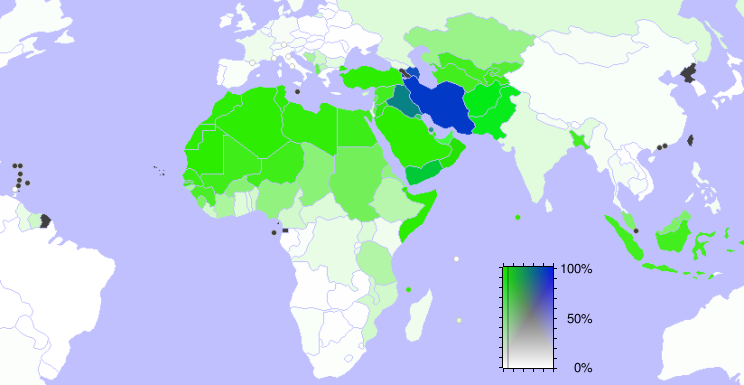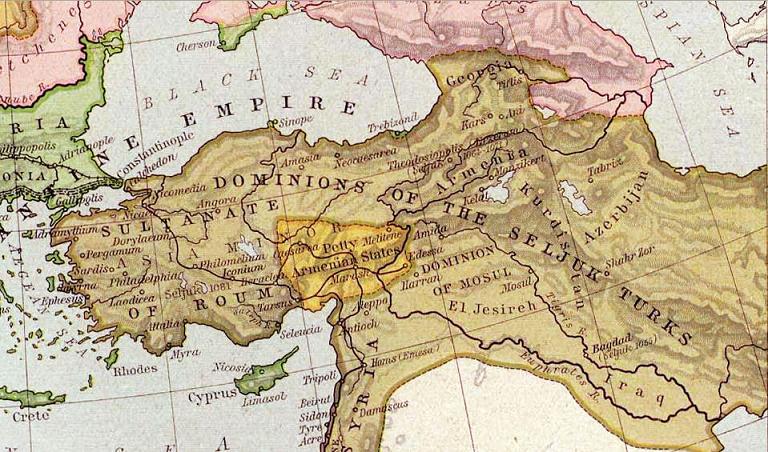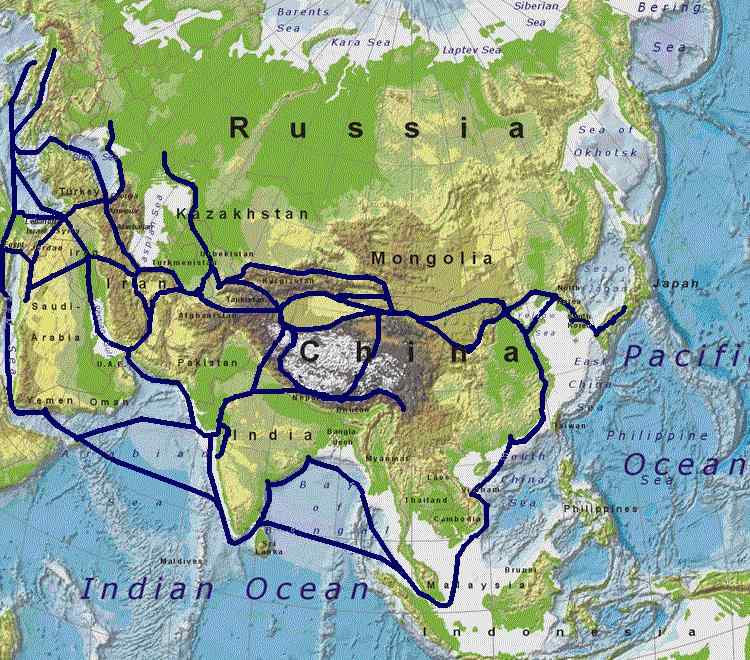2009 Uzbekistan Stamp, showing the Silk Road

Topics on this page
A. the sources of disagreement between Sunnis and Shi’ites
B. the growing influence of Turkish Islam after 1000
C. the importance of the trade routes connecting the Far East and Europe and the role of the Mongols in increasing trade along these routes, including the silk routes to China
D. the relationship of trade to the growth of Central Asian and Middle Eastern cities
E. the sources and uses of slaves in Islamic societies as well as the extent of the Islamic slave trade across Africa from 700 CE on
Dramatic Event page on Islam's Golden Age
Focus Question: What were the main political, economic and religious developments in Islamic history?
Background:
A. The sources of disagreement between Sunnis and Shi’ites
 |
| Distribution of Islam, Sunni (green) and Shi'a (blue), 2006. Countries in black have no data. |
After the death of Muhammad, the problem of who should replace him and care for the umma,or community.
Three caliphs, or chief Muslim rulers, followed.
However when the fourth caliph, Ali, took control, problems arose because he was Muhammad’s cousin and brother-in-law.
This caused the split when the Shi’ites claimed that the first three caliphs were illegitimate because they were not along the line of divine succession, meaning they were not related to Muhammad.
The Sunni
The Sunni branch, approximately 85% of all Muslims, argued that the Caliph should belong to Muhammad’s tribe, the Qurayah, and that the community should choose him by the process of consensus (ijma).
- Since Muhammad was the “Seal of the Prophets,” the Sunnis considered the responsibilities of the Caliph merely to guard—not continue—the prophetic legacy, and to provide “for the administration of community affairs in obedience to the Qur’an and prophetic precedent” (Kerr, 1982, p. 330).
The Shi’a
The other major branch of Islam, Shi’a, claims approximately 15% of the Muslim population and are primarily located in Iraq and Iran.
- This branch is generally considered the more militant wing of the Islamic faith. The Shi’ites, as those comprising the Shi’a sect are called, splintered from the Sunnis primarily over the question of the Caliphate. Regarding this matter, there are specifically two points of disagreement between Shi’ites and Sunnis.
For a NPR broadcast explaining the origins of Sunni-Shi’a conflict, see NPR series The Partisans of Ali Overview Part 1.
The late Ayatollah Khomeini, perhaps the most widely remembered Shi’ite leader among contemporary Westerners.
For a brief 5 minutes video about the 1979 Iranian Revolution where Ayatollah Khomeini came to power in Iran, click here.
- For more information Sunni and Shi'a Islam differences, see Sunni and Shi'a Islam
- New York Times article outlining major characteristics and differences between Sunni and Shi'a Muslims
- NowThis World video on Sunni and Shi'a differences in the modern era
For more information on a third sect of Islam, the mystical Sufism, click here.
Click this link for an understanding of women in Shi'ism
B. The growing influence of Turkish Islam after 1000
For almost 400 years, a succession of Turkic peoples entered eastern Islamdom from Central Asia. These nearly continuous migrations can be divided into three phases: Seljuqs (1055-92), Mongols (1256-1411), and neo-Mongols (1369-1405). The modern nation of Turkey is named after its Turkish inhabitants, but the Turks were not originally from Turkey. Turkish Islam overtook Christianity in the region and eventually became a significant part of the Ottoman empire.
 |
| The Seljuqs in present-day Turkey. |
During the Middle Ages, Islamic Turks played a prominent role in scientific and technological developments, as well as the organization and promotion of education (known as madrasa education) as a duty to the state and to one's religion. This began under the Seljuqs and continued under the Ottoman Empire. Read more here
Due to a number of interrelated factors (such as climatic changes, the strain of growing populations, and pressure from stronger neighbors), the Seljuqs began moving into the Anatolian peninsula (modern-day Turkey). Click here for a brief history of the Seljuqs from the MET Museum and to view some of the art from that period.
Click here for a great website that includes the history of the Ottoman Empire, maps, military information, arts and culture, and more.

The Hagia Sophia
Link to Hagia Sophia (532-37)
One of the main influences of the conquest of the Turks was the conversion from Christianity to Islam.
C. The importance of the trade routes connecting the Far East and Europe and the role of the Mongols in increasing trade along these routes, including the silk routes to China
For more on the Silk Road, link to AP World History Key Concept 3.1 and AP World History Key Concept 2.3.
Link to Ibn Battuta, 14th Century Muslim Traveler

The historical significance of various trade routes are often noted by the exchange of tangible resources from relatively isolated regions and inherently lead to the transmission of cultures from one region to another.
The Silk Road and the Maritime Silk Routes were actually not just one single pathway, but a branching of several land and water passages of varying topography coming from the west through Central Asia.
- Many precious commodities were traded throughout the route, from gold and ivory to animals and plants.
- Additionally, this route didn't just exist for the sole purpose of trading goods as valuable as silk, but also acted as a persuasive route to share religion--the silk route was instrumental in proliferating Buddhism from India to China.
- When the Mongols (led by Genghis Khan) began to siege territorial power through the enhanced communication that the route enabled, a significant interaction of cultural foundations of different regions took place.
- The Mongol Empire was known as the largest contiguous empire in world history.
- Compounding with the reality that Mongols were relatively tolerant of various religions, many nationalities and creeds were able to live in close proximity and enhance the ability to trade within the empire.
As a means to examine the importance of culture within these regions, the non-profit education site, The Silk Road Project supplies videos, music, and maps to help provide multicultural resources for educators.
Crash Course video about the Silk Road.
 For teaching material, see the educator section of the International Dunhuang Project: The Silk Road Online**.
For teaching material, see the educator section of the International Dunhuang Project: The Silk Road Online**.
Explore maps, timelines, music, and historic cultural sites and try your hand at trading on the Silk Road here
This link offers information about the Silk Road from The United Nations Educational, Scientific, and Cultural Organization.
From Silk to Oil: Cross-Cultural Connection Along the Silk Roads offers curriculum materials for teachers and students.
Secrets of the Silk Road from the Penn Museum presents a short overview of gallery images.
This site explains the role of women in the Silk Road.
In 1453 CE, the Ottoman Turks sacked the city of Constantinople, bringing an end to the Byzantine Empire. With the newly positioned Ottomans interfering with the trade routes along the Silk Road, European leaders had to find new ways to trade for Asian commodities. The fall of Constantinople, therefore, was the fall of the Silk Road.
D. The relationship of trade to the growth of Central Asian and Middle Eastern cities
The Expansion of trade enabled Central Asian and Middle Eastern cities - such as Baghdad, Cairo, Damascus, and Marrakech - to grow and flourish.
The Islamic Empire established trade relationships with the Byzantine Empire, Southeast Asia, China and East and West Africa. Goods such as gold, silk, wheat, ivory, and sugar were brought into the Middle East by ships and camel caravans. Check out this page about trade and commercial activity in the Byzantine and Islamic Empire.
These trading relationships were made possible by the use of banking, currency, and credit. (Duiker and Spielvogel, "The Essential World History," Thomson Wadsworth, 2008. Pg. 156)
Safavid Empire(1501-1736) was located in modern day Iran and rose to challenge the Ottoman and Mughal Empires.
Click here for an interactive video lesson plan about the Safavid Empire.
Explore the Learning Module: Women in Islamic History including primary source documents and lesson plans from Center for History and New Media at George Mason University.
Check out this Link with information about Women in Islam from the International Association for Sufism.
Author and activist Samina Ali dispels myths of Islam's oppression of women and discusses the Quranic history of the hijab and its role in modern-day Islam in this TedTalk.
For a lesson plan on two major Islamic cities, Baghdad and Cordoba, click here.
The sources and uses of slaves in Islamic societies as well as the extent of the Islamic slave trade across Africa from 700 AD on.
The Islamic religion prevents Muslims from being enslaved. In an effort to circumvent these religious edicts, Islamic society had to import non-Muslim slaves from other regions.
Here is a link to Arabs and the Slave Trade, an explanation of the Islamic Slave Trade and why there is not a larger African population in the Middle East like in the Americas.
Most often, these slaves came from Africa and parts of Asia outside the empire.
- They were made to serve in the army or as domestic servants, and in some instances, allowed to purchase their own freedom.
- Islam was heavily involved in the slave trade from 700 AD on and made incursions by both land and sea into East and West Africa to bring slaves into Middle Eastern markets. (Duiker and Spielvogel, "The Essential World History," Thomson Wadsworth, 2008. Pg. 158).
- Here is a BBC article about slavery in the Islamic world.
Brandeis University’s “The Feminist Sexual Ethics Project provides a short article examining the origins of slavery in Islamic tradition and connected these beliefs to the current exploit of female labor in contemporary Islamic culture.
For every man, there were two women sent to the Middle East. This was opposite of the Atlantic slave trade.
Here is New York Times article about the African Slave Trade in the Islamic World.
Click this link to learn more about the ways in which Africa was influenced by the spread of Islam.
For more information on notable Muslims of Black/African origin, click here
Additional Resources:
Crash Course video about Islam and politics, connecting it to modern day event, such as the rise of ISIS.
 The Burqa, Chador, Veil and Hijab! Historical Perspectives on Islamic Dressfrom the Women in World History Curriculum project.
The Burqa, Chador, Veil and Hijab! Historical Perspectives on Islamic Dressfrom the Women in World History Curriculum project.
Here is a PBS video analyzing the anti-Islam culture in America as a result of the attacks on 9/11. (For more information, see World History II.48)
Lesson plan for women in Islamic history, and lesson plan for women's rights / status in Islamic society.
Interactive website containing the poetry of Abu Nuwas, an important openly gay poet of the Islamic Golden Age.
This article from the New York Times talks about Turkey's Gay Pride Parade held in 2015. It also explains the the intolerance of homosexuality in many Middle East Countries
Check out Jill Claster's book Sacred Violence for detailed information on Crusade Era Islamic, Christian, and Jewish history and relations.
Links:
[1] Cult and Sects of Islam. Retrieved February 12, 2010, Web site: http://www.apologeticsindex.org/i07ad.html
[2]What’s the Difference: Sunni & Shi’a? Retrieved February 12, 2010, Web site: http://www.neatorama.com/2007/03/13/whats-the-difference-shia-vs-sunni/
3] NPR: “The Partisans of Ali.” Retrieved February 12, 2010, Web site: http://www.npr.org/templates/story/story.php?storyId=7309835&ps=rs
[4] The Silk Road Project. Retrieved February 12, 2010, Web site: http://www.silkroadproject.org/
[5] The Feminist Sexual Ethics Project: Retrieved February 13, 2012, Web site: http://www.brandeis.edu/projects/fse/Pages/islamandslavery.html
http://originalpeople.org/the-arab-muslim-slave-trade-of-africans-the-untold-story/
Comments (0)
You don't have permission to comment on this page.